TG What Is GSS?
{ GSS Teacher Guide Index } { All GSS Books }

Global Systems Science (GSS) is an interdisciplinary course for high school students that emphasizes how scientists from a wide variety of fields work together to understand significant problems of global impact. The “big ideas” of science are stressed, such as the concept of an interacting system, the coevolution of the atmosphere and life, the goal of a sustainable world, and the important role that individuals play in both impacting and protecting our vulnerable global environment.
GSS was developed by a collaborative team of teachers, scientists, and curriculum developers, so that it reflects both the cutting edge of modern interdisciplinary science, and the practical realities of the classroom.
The target audience for this course encompasses the entire range of high school students from grades nine through twelve. The series of Student Books may be used for a one-year integrated science course; or individual Books may be incorporated into existing high school biology, physics, chemistry, Earth science, or social studies courses.
Global Systems Science involves students actively in learning. They perform experiments in the classroom and at home. They read and discuss background materials. They “meet” a selection of scientists, both men and women, from a variety of ethnic and educational backgrounds. They work together to dramatize their ideas for working toward solutions to worldwide environmental problems. They are challenged to make intelligent, informed decisions and to take personal actions, such as conserving energy, recycling, and preparing for their role as voting citizens in a modern industrialized society.
The GSS Student Books
The instructional materials for Global Systems Science consists of this Teacher’s Guide and nine Student Books, each of which focuses on a different aspect of global environmental change. Each Book contains laboratory experiments, home investigations, descriptions of recent scientific work, historical background, and consideration of the economic, political, and ethical issues associated with each problem area. Collectively, they constitute a unique combination of studies in the natural and social sciences through which high school students may view the global environmental issues that they will confront within their lifetimes.
The nine Student Books are divided into four areas: A New World View, Key Environmental Problems, Fundamental Earth Systems, and Underlying Causes and Possible Solutions. The nine books can be presented in any order except for the first one, A New World View, which introduces the GSS approach to the study of our planet. Each book is briefly described on the following pages.

A New World View
…introduces all of the other Books in the Global Systems Science series, and presents four key ideas that thread through the entire course: First, the Earth has tremendously diverse environments, yet it is a single planet that we all call “home.” Second, we can better understand the Earth if we think of it in terms of systems. Third, everything is connected to everything else. And fourth, the goal of global studies is to find out what we can do to sustain life on Planet Earth—now and in the generations to come. To learn about the value of laboratory work for investigating Earth systems, students design and conduct controlled experiments to determine how to sustain life inside a terrarium.
Key Global Problems
Three Books in the GSS series are concerned with environmental problems which affect the entire planet—climate change, depletion of the world’s ozone layer, and loss of species. These issues were selected because they are clearly global in nature, each represents a potential threat to life and prosperity on planet Earth, and each illuminates important aspects of the interaction between human activities and Earth systems.
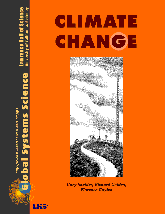
Climate Change
…addresses the controversial question of how human activities may be changing Earth’s climate. It takes students on a “field trip” to Mauna Loa Observatory where they see how scientists have measured carbon dioxide in the Earth’s atmosphere since 1957. They graph and interpret data from Mauna Loa and other observatories which led to the prediction, in 1988, that changes in our atmosphere will cause the entire globe to gradually warm up. They also measure carbon dioxide in the laboratory to find out how much is contained in a sample of human breath and car exhaust. The Book goes on to show how the discoveries at Mauna Loa have been challenged by other scientists in the early 1990’s, and discusses the consensus of opinion about global climate change that finally emerged in 1995. The Book identifies scientific questions which still remain unanswered, and involves students in thinking about the economic, political, and ethical implications of regulating human activities to reduce the likelihood of global climate change.
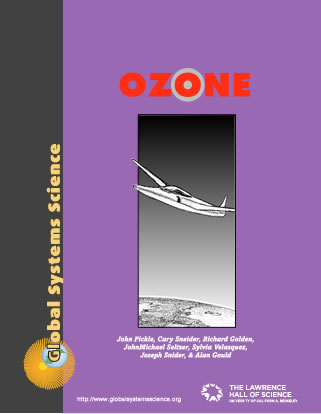
Ozone
…is a success story about how people around the globe are cooperating to solve a serious environmental problem. Ozone gas in the upper atmosphere shields our planet from ultraviolet light that is thought to cause skin cancer and cataracts in humans, and that may be harmful to a wide variety of plants and animals. The story of how the depletion of ozone came to be recognized and connected to the production of certain chemicals used in refrigerators, air conditioners, and the computer industry demonstrates that science can be an exciting and adventuresome field, and that people in a wide variety of careers often play important roles in scientific discoveries. The fascinating epilogue in which more than 100 countries agreed to phase out the ozone-destroying chemicals clearly shows the connection between science and social action. Since ozone will continue to be depleted for several decades due to chemicals already in the atmosphere, your students will learn how to protect themselves by monitoring the levels of UV radiation in their community, and experimenting with sun block to see if it really offers protection from the ultraviolet rays of the sun.
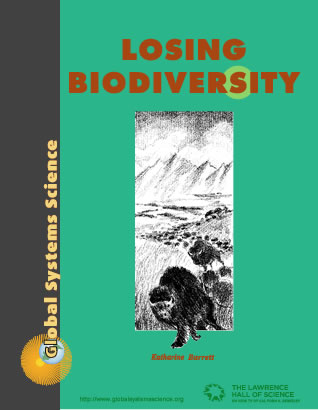
Losing Biodiversity
…is about the endangerment and extinction of entire species of plants and animals throughout the world due to human actions, beginning with the case study of the buffalo. Students learn about the value of biodiversity, from the discovery of new medicines and materials, to the protection of food crops and global systems. The current loss of biodiversity is put into perspective by involving the students in laboratory work where they see how species can adapt to changing conditions, learn theories about how new species evolve, and study the natural causes of extinctions. Further laboratory work illustrates the vital importance and fragility of soil in supporting entire communities of plants and animals; and how soil productivity is impacted by certain agricultural practices. Finally, students consider the history of actions that people around the world have taken to protect endangered species, up to current debates in Congress, and international agreements to preserve biodiversity.
Fundamental Earth Systems
The three student books which make up this portion of the Global Systems Science course put global environmental problems into context by focusing on the natural systems within which human activities occur. Such understanding is essential if we are to grapple with key global problems, and eventually find ways for humans to prosper and thrive without diminishing the rich diversity of life on Planet Earth.
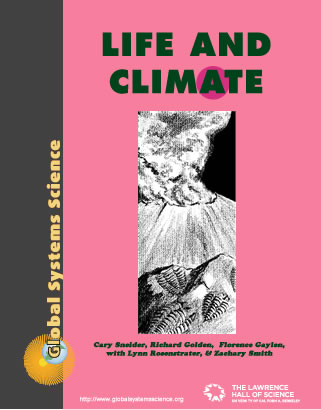
Life and Climate
…is about how our atmosphere and climate came to be as they are today; how life on Earth evolved; and how the evolution of life and climate have affected each other since the Earth was formed. In this Book your students will find the story of how tiny plants brought oxygen to the Earth’s atmosphere; and how changing climates may have brought about the evolution of our human ancestors in Africa five million years ago. They will construct timelines, and find out how we know where to place milestones in the development of life. They will learn about the gradual acceptance of tectonic plate theory, and how the movement of tectonic plates is now thought to cause the climate changes that affected the evolution of life. In the laboratory, your students will experiment with dissolving rocks to explore the long term carbon cycle which has contributed to the long term stability of the Earth’s climate. In the final chapter, they will consider what the Earth’s past can tell us about its future.

Ecosystem Change
…is about the interdependence of all living things and the nonliving environment. It is also about how human activities are changing ecosystems around the world. Through case studies your students will learn about the vastly different kinds of ecosystems, or biomes, on our planet. They will discover that humans have been changing ecosystems for thousands of years; but that the pace of change has increased with the rapid growth of human populations in the last century. In the laboratory, your students will investigate the variables that are important in the process of decomposition, and relate their findings to the biogeochemical cycles that maintain Earth’s biosphere. Through interviews, they will “meet” scientists like Samira Omar of Kuwait, who is studying the ecological effects of the Gulf War; and Dr. Dagmar Werner, who is working to preserve the biodiversity of the rain forests of Central America. They will also find out what people in the United States are doing to reduce human impact on ecosystems, and consider ways that their own actions can make a difference.
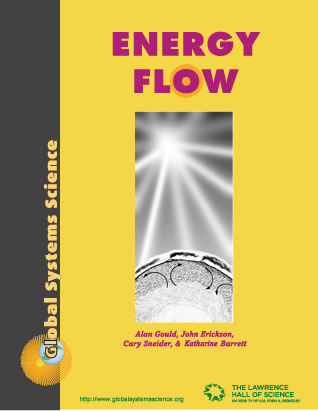
Energy Flow
…is about the way energy flows through the atmosphere, oceans, land, and living things. Analyzing the flow of energy is a very useful way to understand Earth systems. For example, through laboratory investigations, your students will explore the process of convection, and see how this proces is used to understand earthquakes and volcanoes, global winds, and ocean currents. In other lab activities they will experiment with the variables that affect water flowing through a bottle, and then apply their insights about dynamic equilibrium to understanding how the greenhouse effect is expected to change the Earth’s climate. In the last chapter your students will learn about how some of the energy that flows through living systems has been stored, over millions of years, in the form of fossil fuels; and how that energy is being released to power our civilizations for a few short decades. With this background, your students are asked to think about how the flow of energy through Earth systems affects their daily lives, and how life might be different for their children and grandchildren.
Underlying Causes and Possible Solutions
Two aspects of our modern age stand out as possibly the most important underlying causes of global environmental change—the rapidly growing human population, and the ways in which people use natural resources for energy. Yet within both areas there is reason to hope that intelligent decisions by individuals can reduce the impact of these problems and lead to a habitable world for future generations.
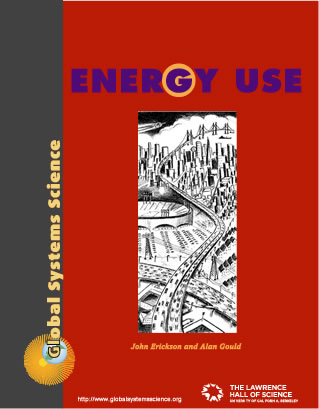
Energy Use
…begins by inviting students to take an inventory of the ways that they use electricity. By “following the wires” back to a power plant, and from there to a grid of all power plants in the country, your students will begin to grasp the vast infrarstructure that supports our way of life. Through laboratory experiments they will learn the basic principles on which electrical devices work; and through a brief history, they will learn how our national energy policy came to be. They will also learn about the huge amounts of Earth materials that are used for transportation, home heating, and industry on a daily basis, and the small fraction of that energy that is actually put to use. In the last portion of the unit your students will conduct simple experiments in which they discover that conservation will allow us to maintain our current levels of energy usage while saving billions of dollars and reducing our impact on the environment. They will also explore new technologies for satisfying the energy needs of a growing human population while keeping the impact of energy use to a minimum.
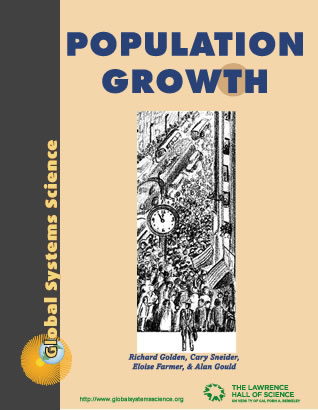
Population Growth
…addresses a fundamental problem: even if we can change our habits to use only clean and efficient sources of energy such as solar, wind, and water power, global environmental problems will continue to worsen if the world’s population continues to grow at the present rate. Today there are over 5 billion people on Earth, and the population increases by one million every four days. Yet it is difficult for students to see the effects of population growth. They are therefore asked to think about the quality of their own lives as a starting point, and to recognize how satisfying their needs takes a share of the Earth’s resources. By comparing their own lives with conditions in countries such as China and India, they will be in a better position to consider what may happen if the human population continues to grow as rapidly as it is today. Through mathematical investigations, your students will learn about factors that contribute to the rate of population growth, and the idea of carrying capacity, which relates an ecosystem to the populations it can sustain. The cultural and religious dimensions of efforts to curb population growth are sensitively discussed, and students are encouraged to form their own opinions about what can and should be done by individuals and by governments to control the growth of the global human population.
After the original nine were completed, two more books were added : A Changing Cosmos and Digital Earth Watch.

A Changing Cosmos
…is the latest edition of the Hands-On Universe (HOU) astronomy curriculum series. It is a compilation in a single book as the “Best” of the HOU high school curriculum books developed by TERC. The TERC HOU curriculum had 7 student books, each with a Teacher Guide:
- Table of Contents
- Introduction to Image Processing—how to use the HOU Image Processing Software. Teacher guide.
- Finding Features—including a Browser’s Guide to the Universe. Teacher guide.
- Searching for Supernovae—See how astronomers find supernovae — exploding stars. Teacher guide.
- Measuring Size—Use the pixel plate scale to measure a lunar crater; track Jupiter’s moons; calculate mass of Jupiter. Teacher guide. Teacher guide.
- Measuring Brightness—Learn about photometry — measurement of light from a celestial object. Teacher guide.
- Measuring Distance—Learn how the cosmological distance ladder is used to determine the distance to far away objects. Teacher guide.
- Measuring Color—colors of stars, the HR diagram, and how stars evolve according to their mass. Teacher guide.
- TERC HOU high school Teacher Book; Cover; addenda: Grade 10-12 Physics, Grade 10-12 Astronomy, Grade 11 sequence, Grade 10 sequence,
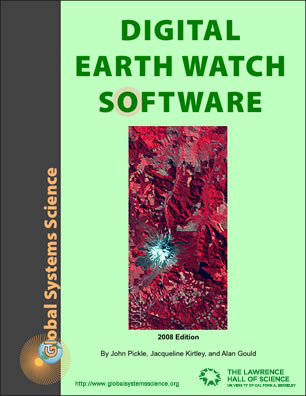
Digital Earth Watch
…is the guide to how to use software for analyzing digital images, both from digital cameras and satellite images of Earth. There are sections on how images are constructed from 3 primary colors, pixels, using software tools to measure length, area, and color. Ultimately learn to determine environmental changes seen in satellite images, including the health of vegetation.
The overall goal of the Global Systems Science course is for students to become scientifically literate citizens, aware of the many ways that their lives are interconnected with the world around them. While many students who enroll in the GSS course may be moved to change their personal behaviors, or undertake projects to achieve a sustainable world, it is important for teachers to avoid telling students what they “should” do. Individual students may respond to the course in a variety of different, yet equally valid ways. The value of scientific literacy is that it gives individuals the power to make personal choices that are consistent with their growing knowledge and stature as world citizens.
